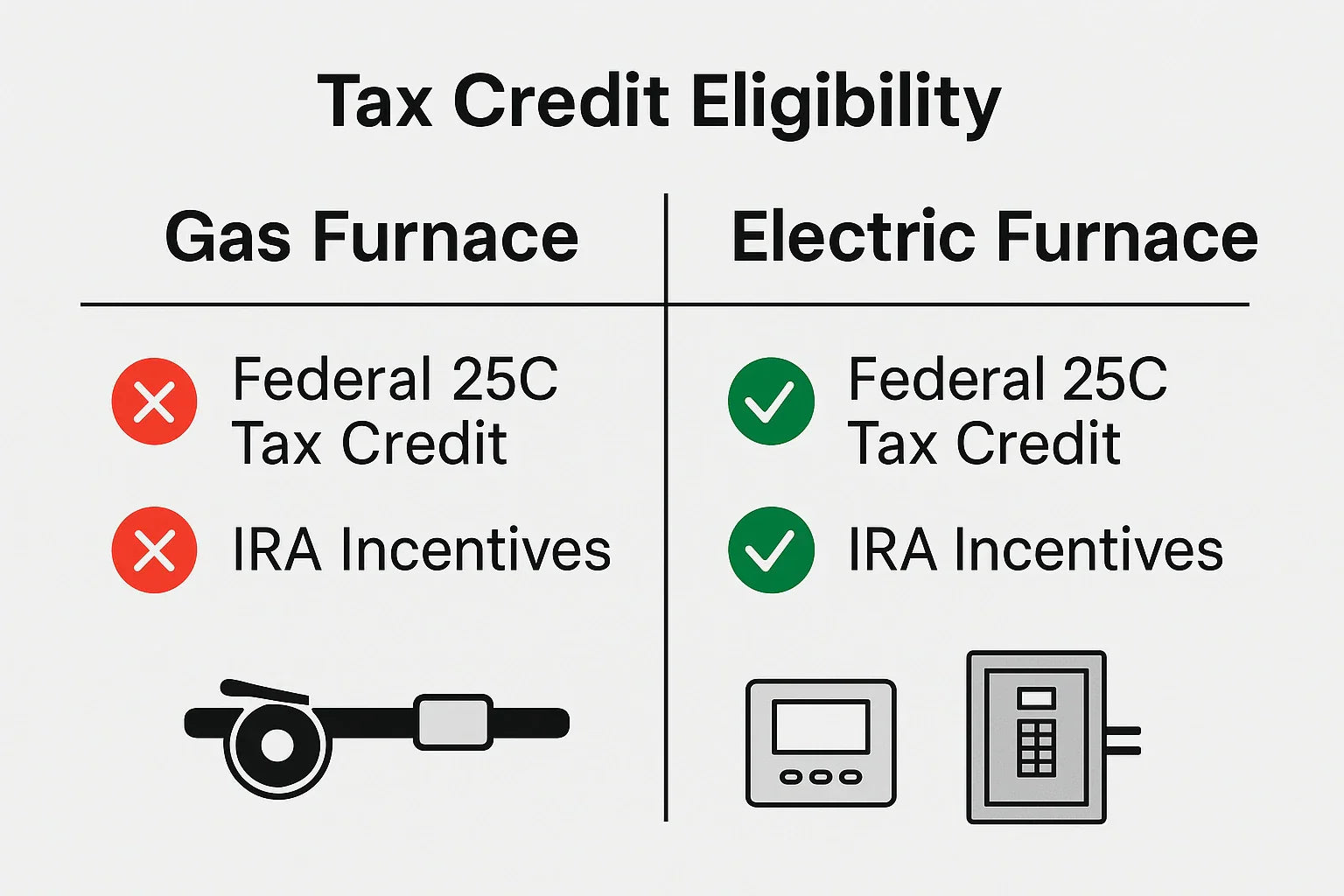Upgrading your home’s furnace isn’t just about comfort—it’s a financial decision that can impact your utility bills, resale value, and tax return for years. But here’s the thing: you might not have to shoulder the full cost alone.
With federal tax credits, state-level rebates, utility programs, and manufacturer financing on the table in 2025, choosing between gas and electric furnaces has become just as much about incentives as performance.
So, which option puts more money back in your pocket? Let’s break it down.
Why Incentives Matter More Than Ever
A high-efficiency furnace can cost anywhere from $3,000 to $7,500 or more depending on size and setup. Incentives can:
-
Offset upfront installation costs
-
Reward energy-efficient choices
-
Help you qualify for low-interest financing
-
Tip the scales toward future-proofing your home
And because electric heating aligns more closely with decarbonization policies, it’s seeing more aggressive support in some areas. But gas still qualifies in many rebate programs—especially for high-efficiency models.
Federal Tax Credits: Who Qualifies in 2025?
🔧 Energy Efficient Home Improvement Credit (25C)
Thanks to the Inflation Reduction Act (IRA), this credit allows homeowners to claim:
-
Up to $600 for qualified gas or electric furnaces
-
$2,000 for electric heat pumps
Eligible models must meet ENERGY STAR® standards, and installation must occur in your primary residence.
⚡ Extra Incentives for Electric Heating
While gas systems still qualify under 25C, electric systems get more attention under broader electrification goals. If you upgrade your panel or wiring to support an electric furnace, you may qualify for:
-
Up to $600 for electrical panel upgrades
-
Additional credits if paired with solar or other clean energy systems
State and Local Rebates: A Mixed Landscape
Depending on where you live, your local incentives may heavily favor electric—or include generous gas incentives too.
Key Highlights by Region:
-
California & New York: Push electric heat over gas
-
Midwest & Mountain West: Often support both, favoring high-efficiency upgrades
-
Southern states: Emphasize cooling systems but offer dual-fuel rebates
Use the DSIRE database to explore your state’s latest rebates and programs.
Utility Rebates: What Your Provider Might Offer
Many local utility companies offer rebates for:
-
High-efficiency gas furnaces (90%+ AFUE)
-
Electric furnaces or mini-splits
-
Smart thermostats that help manage energy use
Some even offer bonus rebates if you complete a home energy audit first.
For example:
-
Xcel Energy (CO & MN) provides $400–$500 for high-efficiency gas or electric furnace installs
-
Mass Save® offers rebates up to $1,000 for qualifying electric heating upgrades
Manufacturer and Retail Financing Options
Don’t overlook factory-sponsored financing—especially during seasonal promos. Many manufacturers now offer:
-
0% APR for 12–24 months
-
Deferred payments for 6 months
-
Bundled rebates for buying furnace + thermostat + air purifier
Top brands like Lennox, Carrier, and Trane often roll out promotions in spring and fall shoulder seasons.
What to Ask Before You Buy
Whether you’re talking to an installer or your utility rep, ask:
-
❓ Does this system qualify for federal, state, and utility rebates?
-
❓ Do I need a home energy audit to unlock maximum rebates?
-
❓ Are financing or loan programs available for this furnace type?
-
❓ Will switching from gas to electric affect my panel or service load?
Tip: If your project touches multiple systems (like ductwork, thermostats, or insulation), you may qualify for stackable incentives that go beyond the furnace itself.
Which Type Wins on Incentives in 2025?
| Category | Gas Furnace ✅ | Electric Furnace ⚡ |
|---|---|---|
| Federal Tax Credit (25C) | ✅ Up to $600 | ✅ Up to $600 (or more w/ panel upgrades) |
| State Incentives | ✅ Some states | ⚡ Strong in electric-priority states |
| Utility Rebates | ✅ Available in most | ⚡ May be larger in clean-grid areas |
| Financing Offers | ✅ Common | ✅ Common |
| Long-Term Policy Support | ⚠️ Uncertain future | ✅ Expanding under IRA |
Electric heating is clearly getting a policy boost at the federal and state level, particularly in regions committed to carbon reduction goals. But high-efficiency gas furnaces still hold their own where the grid is fossil-fuel heavy or winters are extreme.
Final Thoughts: Don’t Leave Free Money on the Table
Rebates, tax credits, and financing can save you hundreds to thousands on a new furnace—but only if you choose models that qualify and stack the right programs.
Looking for guidance on conversions between systems?
👉 Read next: Can You Convert from Electric to Gas (or Vice Versa)? What to Expect
Still deciding between gas or electric overall?
👉 Start here: Gas vs. Electric Furnaces: Which is Better?
Alex Lane
Your Home Comfort Advocate







